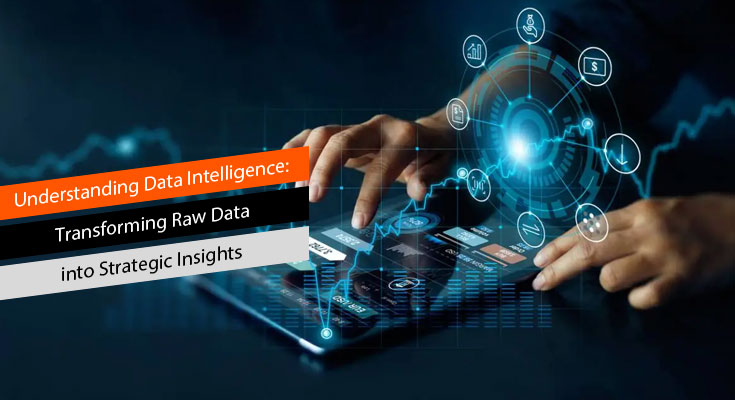In the age of digital transformation, data is often referred to as the “new oil.” Yet, just like crude oil, raw data in its unrefined form holds limited value. It must be processed, analyzed, and contextualized to unlock its true potential. This is where data intelligence plays a critical role.
Data intelligence goes beyond basic data collection. It’s a sophisticated process that turns raw data into actionable insights that guide decision-making, shape strategies, and drive innovation. In this post, we’ll explore what data intelligence is, how it works, its benefits, and how organizations can leverage it to gain a competitive edge.
What Is Data Intelligence?
Data intelligence is the practice of collecting, integrating, analyzing, and interpreting data to support strategic planning and operational efficiency. It involves the use of analytics tools, machine learning models, and artificial intelligence (AI) to derive meaning from vast amounts of data.
Unlike traditional business intelligence, which often relies on historical data and structured reports, data intelligence taps into both structured and unstructured data sources, offering real-time, predictive, and prescriptive insights.
The Data Intelligence Lifecycle
Understanding the lifecycle of data intelligence is crucial to leveraging its full potential. Here’s a breakdown of the typical stages:
1. Data Collection
This involves gathering data from various sources—customer interactions, transaction records, IoT devices, social media, web logs, and more. Modern organizations often work with Big Data, which encompasses high volume, velocity, and variety.
2. Data Cleaning and Preparation
Raw data often includes inconsistencies, duplicates, or missing values. Data must be cleaned and formatted to ensure accuracy and usability. This step is critical because poor data quality can skew insights and lead to faulty decisions.
3. Data Integration
Organizations rarely use data from a single source. Integration tools and data warehouses combine disparate datasets, allowing analysts to see the complete picture.
4. Data Analysis and Modeling
This phase uses statistical tools, machine learning algorithms, and AI to identify patterns, trends, and relationships. Techniques like clustering, regression, and natural language processing (NLP) help uncover deep insights.
5. Visualization and Reporting
The final output of data intelligence is often presented through dashboards and reports, enabling stakeholders to make informed decisions. Visualization tools like Power BI, Tableau, or Looker help translate complex analytics into intuitive graphics.
6. Strategic Action
Insights are only valuable when acted upon. Businesses use the outcomes of data intelligence to optimize operations, improve customer experiences, forecast trends, and create competitive strategies.
Benefits of Data Intelligence
1. Enhanced Decision-Making
Data intelligence supports data-driven decisions, reducing reliance on gut feelings or guesswork. It allows leaders to validate assumptions and simulate potential outcomes before committing to a course of action.
2. Improved Customer Experience
By analyzing customer behavior and preferences, organizations can tailor products, services, and communication to meet specific needs, thereby increasing loyalty and retention.
3. Operational Efficiency
Data intelligence identifies inefficiencies and bottlenecks in business processes. For example, a logistics company might use it to optimize delivery routes, reducing fuel costs and improving delivery times.
4. Risk Management
Predictive analytics can flag potential risks—such as fraud, supply chain disruptions, or customer churn—before they become significant problems, enabling proactive intervention.
5. Innovation and Product Development
Companies use data to identify market gaps and emerging trends. This fosters innovation, as businesses can design products or services that meet evolving customer demands.
Key Technologies Powering Data Intelligence
- Artificial Intelligence (AI): Enables systems to learn and improve over time, delivering more accurate predictions.
- Machine Learning (ML): Automates pattern recognition and decision-making processes.
- Natural Language Processing (NLP): Allows computers to interpret and analyze human language, useful in sentiment analysis and chatbots.
- Cloud Computing: Provides scalable infrastructure for storing and processing massive datasets.
- Data Lakes and Warehouses: Centralize and manage data from multiple sources in one accessible platform.
Real-World Applications of Data Intelligence
- Retail: Analyzing purchase behavior to recommend personalized products.
- Healthcare: Predicting patient readmissions or identifying at-risk individuals through health records.
- Finance: Detecting fraudulent transactions in real-time.
- Manufacturing: Monitoring equipment performance to predict maintenance needs.
- Marketing: Understanding campaign effectiveness and optimizing ad spend.
Challenges and Considerations
While data intelligence is powerful, it’s not without challenges:
- Data Privacy: Regulations like GDPR and CCPA require organizations to handle data responsibly.
- Data Silos: Disconnected systems can hinder integration and limit insight generation.
- Talent Gap: Skilled data scientists, analysts, and engineers are in high demand.
- Bias in Data: Algorithms are only as good as the data they’re trained on. Biased data can lead to discriminatory outcomes.
Organizations must also foster a data-driven culture, where employees at all levels understand the value of data and are empowered to use it in their roles.
The Future of Data Intelligence
As technology advances, data intelligence will become increasingly sophisticated. Emerging trends include:
- Augmented Analytics: Where AI assists users in understanding data without deep technical knowledge.
- Edge Computing: Processing data closer to where it is generated for real-time insights.
- Automated Decisioning: AI systems that not only analyze data but act on it without human intervention.
These innovations will make data intelligence more accessible and powerful, turning it from a competitive advantage into a business necessity.
Final Thoughts
Data intelligence is transforming the way organizations operate. By converting raw data into strategic insights, businesses can make smarter decisions, delight customers, and innovate faster. However, to fully capitalize on its potential, organizations must invest in the right tools, talent, and culture.
In a world driven by information, those who master data intelligence will lead the future.


